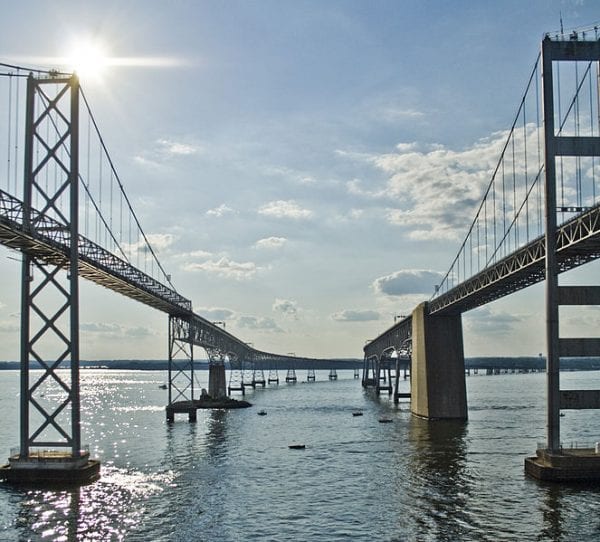
Maryland’s Rain Tax Soaks Everybody
Taxpayers Protection Alliance
September 25, 2013

Chesapeake Bay Bridge between Anne Arundel & Queen Anne’s Counties
The Taxpayers Protection Alliance is always amazed at the ways in which government at all levels seeks to wreak havoc on the wallets of taxpayers. There is no shortage of terrible ideas coming from elected officials these days when it comes to taxes because government at all levels is lazy and wants to raise taxes instead of cutting spending. One of the most egregious recent examples comes from Maryland and it is called the “Storm Management Fee” or otherwise known as the ‘Rain Tax,” and believe us when we say, that is exactly what it is, a tax on Maryland residents when it rains. And, as the saying goes, when it rains, it pours. Although Montgomery County, Maryland had their own lite version of the Rain Tax (a Water Quality Protection Charge that amounted to $92.60/year on property tax bills), this new selective tax (since it only applies to the 10 counties with the largest populations in Maryland of 24 total jurisdictions) is far more invasive and costly to the taxpayers and has both statewide and national implications.
The roots of this ridiculous tax date back a few years ago. Blair Lee of The Gazette, describes the origins:
“In 2010 the Obama administration’s Environmental Protection Agency ordered Maryland to reduce stormwater runoff into the Chesapeake Bay so that nitrogen levels fall 22 percent and phosphorus falls 15 percent from current amounts. The price tag: $14.8 billion.
And where do we get the $14.8 billion? By taxing so-called “impervious surfaces,” anything that prevents rain water from seeping into the earth (roofs, driveways, patios, sidewalks, etc.) thereby causing stormwater run off. In other words, a rain tax.”
The EPA subsequently ordered the state of Maryland to come up with the nearly $15 billion and Maryland shifted that burden to their 10 largest counties when the state legislature passed the Stormwater Management – Watershed Protection and Restoration Program. Governor Martin O’Malley followed this with a “decree” that made the Rain Tax official July 1st of 2013.
There are several problems with the Rain Tax and we are seeing just how much these problems impact the effectiveness and the wisdom of such ridiculous policy. The first problem is that the taxes being paid are as the Tax Foundation describes, “convoluted and disorganized” as you look from county to county.
The Rain Tax could be comparably as complicated as the US Tax Code. Second, there are real economic consequences from a tax that a business owner could see coming from a mile away. When the Rain Tax comes due, businesses take a major hit, some to the tune of thousands of dollars. Finally, the implementation has been anything but smooth. A report from the Maryland Public Policy Institute calls it poorly conceived, ineptly handled, and notes that it probably won’t even meet the very goals initially stated as reasons for being imposed in the first place.
With criticism coming from all directions, it would seem that there is hope such a monstrosity of legislation can be disposed of, right? In fact, some counties have already made their move to oppose the Rain Tax or at least make sure their fee was as small as possible. Two specific examples are Carroll County, where commissioners refused to adopt a fee; and Frederick County, which approved a nominal 1-cent charge. In Harford County, the fees were set at $125 for residential and agricultural properties, and $7 for every 500 square feet of impervious surface for commercial properties; but last week, GOP Gubernatorial candidate David R. Craig said he will try to repeal of his jurisdiction’s Rain Tax.
Folks are noticing. According to a July 2013 story by CBS Channel 13 in Baltimore, “’I thought it was a joke. How can you tax the rain? But when I got the $4,700 rain tax bill, it wasn’t funny anymore,’ said Nancy Correlli, Baltimore Boating Center. She’s not alone. Ron Gates, a local business and commercial property owner says he’s taking a bath. ‘First one went up 80 percent, the second one went up 60 percent, and the last one went up 42 percent,’ he said. ‘I know myself, I was blindsided. When I opened the tax bills, I couldn’t believe the numbers. It totally floored me.’”
Republican lawmakers in the Maryland General Assembly tried after the EPA “decree” to come up with commonsense solutions including efforts to address the Conowingo Dam, a major source of Chesapeake Bay pollution. According to a July 16, 2013 article in the Baltimore Sun “The dam’s inability to filter the flow of pollutants from the Susquehanna River, a major conduit of the bay’s pollution, poses a real threat to any effort to prevent polluted rain water from flowing into the bay. Indeed, there are alternatives to the O’Malley administration’s rain tax.”
The Rain Tax is an excellent example of how federal and state officials can (and do) join together to cause great harm to taxpayers, consumers, and businesses with just the stroke of a pen. When you have blanket directives coming from a federal agency and high tax Governors and state legislatures, the result is bound to be disastrous. The EPA directive that began this mess wasn’t just focused on Maryland (New York, Pennsylvania, Virginia, West Virginia and the District of Columbia were in the crosshairs). The directive allowed the states to come up with their own solution and in Maryland, the Democrat-controlled legislature and Governor O’Malley gave the 10 most populous counties the bill for the entire state. The Rain Tax is ridiculous from start to finish. The idea was conceived poorly, the standards set were completely unfair and selective, and the implementation has been a disaster.
The Taxpayers Protection Alliance is dedicated to educating the public on issues that have an impact on their lives and their wallets, and it is important to understand that the desire from federal agencies and statewide elected officials are seemingly always looking for ways to get more money from the taxpayer. The Rain Tax is just another example of how some states are taking taxation to a whole new level and doing damage, both short-term and long-term, to the economic climate that is so crucial to making local businesses successful and keeping taxpayers employed.
The answer to every problem shouldn’t always default to taking more money from taxpayers.
